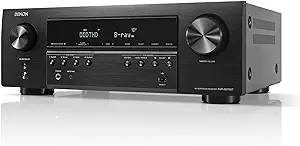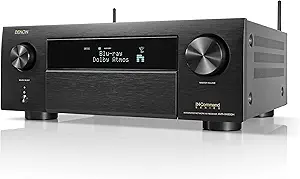Denon AV Receivers
In the realm of home entertainment, audio-visual (AV) receivers play a pivotal role in delivering immersive sound and video experiences. Among the plethora of options available, Denon AV receivers stand out as a hallmark of quality, performance, and innovation. In this article, we will delve into what makes Denon AV receivers exceptional, their distinguishing features, and why they are a compelling choice for audio enthusiasts and home theater aficionados.
What are Denon AV Receivers?
Denon AV receivers are sophisticated audio and video components designed to serve as the central hub of a home entertainment system. Renowned for their superior sound quality, versatility, and advanced features, Denon receivers cater to the discerning needs of audiophiles, cinephiles, and casual users alike.
Equipped with cutting-edge technologies, Denon AV receivers decode and amplify audio signals from various sources such as Blu-ray players, gaming consoles, streaming devices, and cable/satellite boxes. Additionally, they facilitate seamless integration with multiple speakers, subwoofers, and video displays to create a captivating and immersive home theater experience.
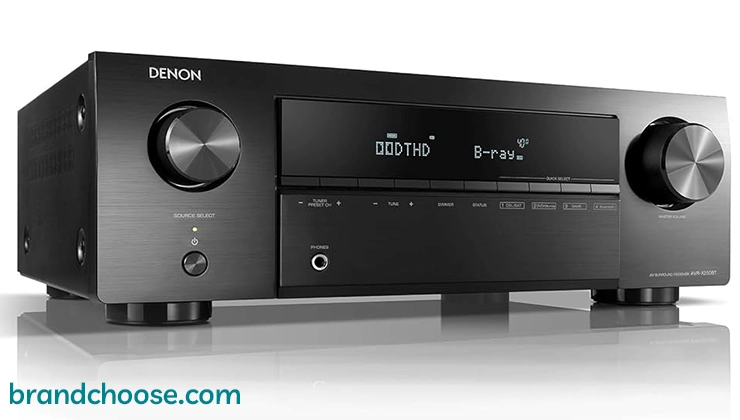
Why are Denon AV Receivers superior?
Denon AV receivers excel in several key areas, setting them apart from their competitors:
Number of channels
Denon, a prominent name in the AV receivers arena, offers a diverse array of products distinguished by varying channel configurations. The number of channels in an AV receiver is pivotal as it dictates the capacity for speaker connections, thus influencing overall audio immersion. Denon's lineup ranges from 5.2 channel models like the AVR-S540BT to top-tier 13.2 channel offerings exemplified by the AVR-X8500H. The latter stands as one of the pioneering AV receivers in supporting 13 channels, facilitating heightened realism in sound reproduction. Denon's high-channel models integrate cutting-edge technologies such as Dolby Atmos, DTS:X, and Auro-3D support, enriching the auditory experience with multidimensional depth. With an escalating number of channels, Denon AV receivers accommodate diverse speaker configurations, including overhead speakers, for an immersive soundscape. However, the drawback of higher channel counts lies in heightened complexity and spatial requirements for speaker setup. In comparison, rival brands like Yamaha and Onkyo also present AV receivers with substantial channel counts, yet Denon distinguishes itself with advanced features and technologies augmenting sound quality and user experience.
Power output
Denon distinguishes itself in the AV receivers domain with impressive power output capabilities showcased in its latest models such as the Denon AVR-X3700H. These receivers boast high power output, reaching up to 105 watts per channel at 8 ohms, ensuring dynamic and immersive audio experiences, whether enjoying movies or music. However, while Denon's power output generally exceeds that of many competitors, it's important to note potential drawbacks, such as heightened energy consumption and reports of receivers running hot, potentially shortening device lifespan if ventilation is inadequate. In comparison with brands like Yamaha and Sony, Denon maintains competitive power output levels, often surpassing comparable models within the same price bracket. However, brands like Marantz may offer comparable or slightly higher power output in their premium models.
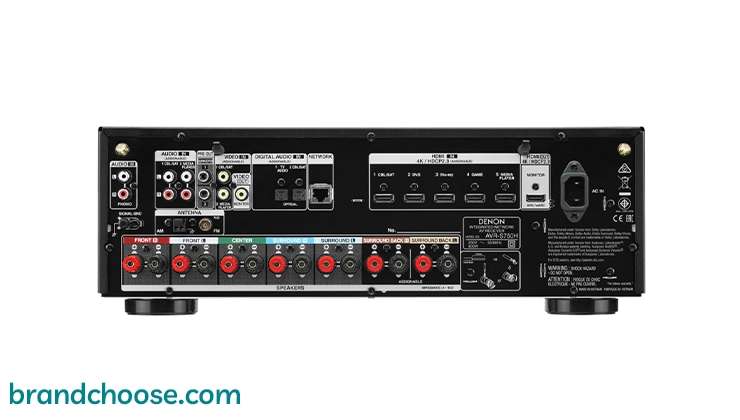
Sound quality
Denon garners acclaim for its exceptional sound quality, underpinned by cutting-edge technologies like Dolby Atmos, DTS:X, and Auro-3D. These innovations facilitate a rich, immersive, and multidimensional audio journey, decoding and reproducing object-based surround sound formats to precisely position and move sounds within the room, thus engendering a lifelike soundscape. The latest models additionally embrace high-resolution audio support, enhancing clarity and detail. Despite the generally stellar sound quality of Denon AV receivers, some users have reported occasional inconsistencies in audio performance, particularly at higher volume levels. Contrasted with competitors like Yamaha and Marantz, Denon receivers often exhibit a warmer and more balanced sound profile, albeit occasionally sacrificing crispness in higher frequencies. Nevertheless, Denon's AV receivers maintain popularity among audiophiles and home theater enthusiasts for their ability to deliver robust, detailed, and immersive soundscapes.
Which Denon AVR is Right For You?
Anthem AV Receivers
In the realm of home entertainment, the pursuit of superior audio quality drives enthusiasts to seek out the best audio-visual (AV) receivers. Among the multitude of options available, Anthem AV receivers stand out as exemplars of innovation, performance, and craftsmanship. In this article, we delve into the realm of Anthem AV receivers, unraveling their unique features, advantages, disadvantages, and why they deserve consideration as the centerpiece of your home theater setup.
What are Anthem AV Receivers?
Anthem AV receivers are high-performance audio-visual receivers designed to deliver exceptional sound quality and immersive home theater experiences. Manufactured by Anthem Electronics, a Canadian-based company known for its commitment to audio excellence, Anthem AV receivers are renowned for their precision engineering, advanced features, and uncompromising performance. These receivers serve as the central hub of a home theater system, decoding audio signals from various sources such as Blu-ray players, gaming consoles, streaming devices, and more. Anthem AV receivers amplify and process these signals to deliver high-quality audio to connected speakers, creating immersive surround sound experiences for movies, music, and gaming.

Feauturs you need to know about Anthem AV Receivers
Audio quality
Anthem, a well-respected brand in the AV Receiver category, is highly praised for its exceptional audio quality. The brand utilizes advanced technologies such as Anthem Room Correction (ARC) system, which is designed to optimize the audio performance to suit the specific acoustics of your room. This technology works by measuring the sound output, comparing it to the scientifically calibrated ideal, and then adjusting the receiver's output to correct for any discrepancies. This results in a cleaner, more precise sound that is tailored to your specific environment. Compared to other brands, Anthem's focus on audio quality is quite evident. While brands like Sony and Yamaha also offer room correction technologies, Anthem's ARC system is often cited as being more sophisticated and effective. However, it's worth noting that this high level of audio quality comes with a higher price tag compared to other brands. Furthermore, some users have noted that the ARC system can be complex to set up and may require some technical knowledge. Despite these minor drawbacks, if audio quality is your top priority, Anthem's AV receivers are hard to beat.
Number of channels
Anthem, a renowned brand in the AV receivers category, offers a range of models with varying number of channels. The brand's lineup includes models like the MRX 520 with 5.2 channels, the MRX 720 with 7.2 channels, and the MRX 1120 with 11.2 channels. The number of channels in an AV receiver determines the level of surround sound it can provide, with more channels allowing for a more immersive audio experience. Compared to other brands, Anthem holds its own in terms of the number of channels it offers. For instance, the MRX 1120's 11.2 channels put it on par with high-end models from brands like Denon and Yamaha. However, it's worth noting that while Anthem receivers deliver excellent sound quality, they tend to be pricier than their counterparts with similar channel counts. On the flip side, the brand's focus on audio performance over extra features can be a pro for audiophiles who prioritize sound quality above all else.
Connectivity options
Anthem, a renowned brand in the AV receivers category, offers a range of connectivity options in their products that are designed to meet the demands of modern home theater setups. Their latest models, like the MRX Series, are equipped with several advanced technologies that enhance their connectivity capabilities. These models feature multiple HDMI inputs and outputs, USB ports for direct connections to music storage devices, and Ethernet ports for network connectivity. They also support wireless connectivity options, including Bluetooth and Wi-Fi, which allow for easy streaming of music from various devices. In comparison to other brands, Anthem stands out with its ARC (Anthem Room Correction) system, which connects to your home network and allows for precise room tuning to optimize sound quality. However, one potential drawback of Anthem's AV receivers is that they do not support HDMI 2.1, which can limit their compatibility with certain newest gaming consoles and 8K TVs. Despite this, the brand's robust connectivity options, coupled with its high-quality sound performance, make it a strong contender in the market against other brands like Denon and Yamaha, which also offer a variety of connectivity options in their AV receivers.
Output
Anthem, a notable brand in the AV receivers category, is highly recognized for its exceptional output capabilities. The brand's latest models, such as the Anthem MRX 1120 and Anthem AVM 60, are equipped with advanced technologies that deliver high-resolution audio and video outputs. They utilize the Anthem Room Correction (ARC) technology, which is a proprietary digital signal processing system that works to optimize the audio output to suit the specific acoustics of your room. This results in a more precise and immersive sound experience. However, while the output quality of Anthem's AV receivers is impressive, they are often considered less user-friendly compared to some other brands. The setup process can be somewhat complex, particularly for those who are not tech-savvy. In terms of output, brands like Denon and Yamaha are Anthem's closest competitors, offering similar high-resolution audio and video outputs. However, Anthem's ARC technology gives it an edge, as it allows for a more customized sound experience. Despite the slight disadvantage in user-friendliness, Anthem's output capabilities make it a strong contender in the AV receivers market.
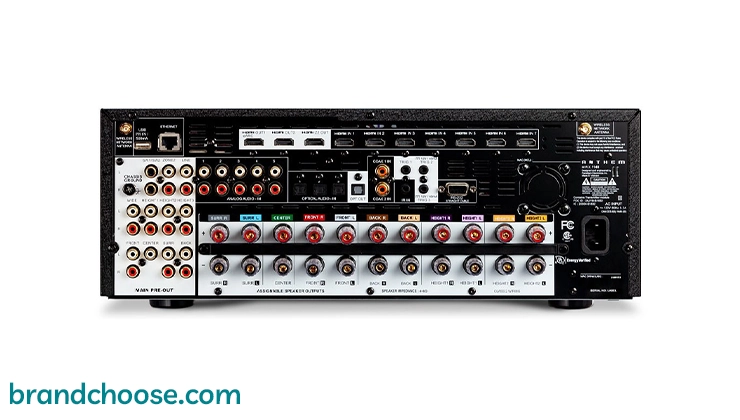
Additional features (like Dolby Atmos, DTS:X, etc.)
Anthem, a renowned brand in the AV receivers category, offers a range of additional features that enhance the user experience significantly. One of the key features is the support for Dolby Atmos, a technology that creates a powerful, moving audio experience that seems to flow all around the user. This feature allows the Anthem AV receivers to deliver a three-dimensional sound that makes any audio experience immersive. Furthermore, most of their models also support DTS:X, another advanced technology that provides multi-dimensional sound, making it a great choice for home theaters. However, while these features are impressive, they are not unique to Anthem. Many other brands in the AV receivers category, such as Denon and Yamaha, also offer Dolby Atmos and DTS:X support. The difference lies in how each brand implements these technologies. Anthem stands out for its ARC (Anthem Room Correction) technology, which adjusts the audio output to suit the acoustics of the room, thereby delivering a more personalized audio experience. On the downside, some users have reported that the setup process for these features can be a bit complex. Nonetheless, once set up, the additional features of Anthem AV receivers significantly enhance the audio experience.
- Sony vs Denon
- Arcam vs Cambridge Audio
- Sony vs Onkyo
- Cambridge Audio vs Harman Kardon
- Sony vs Marantz
- Onkyo vs Marantz
















